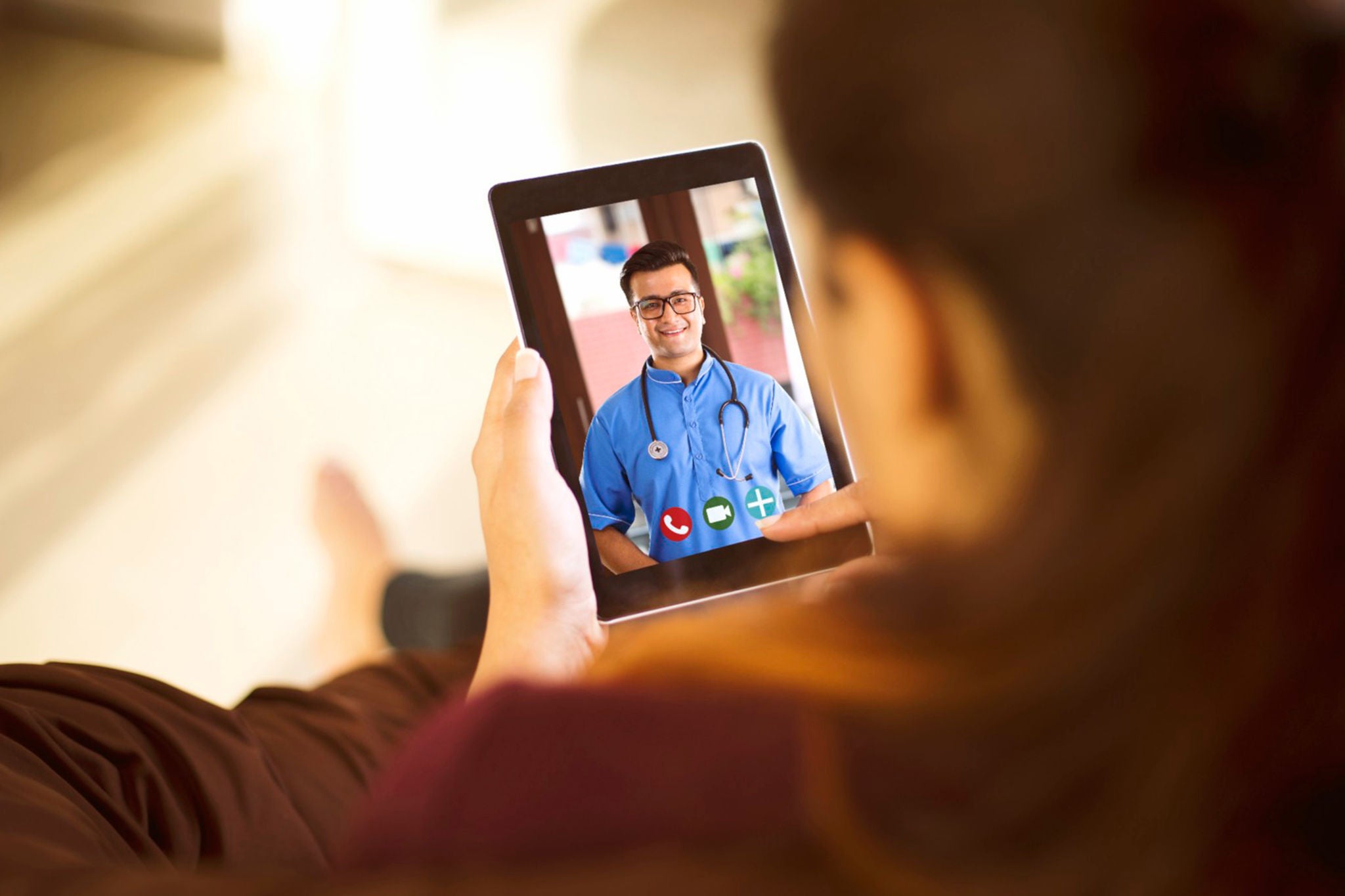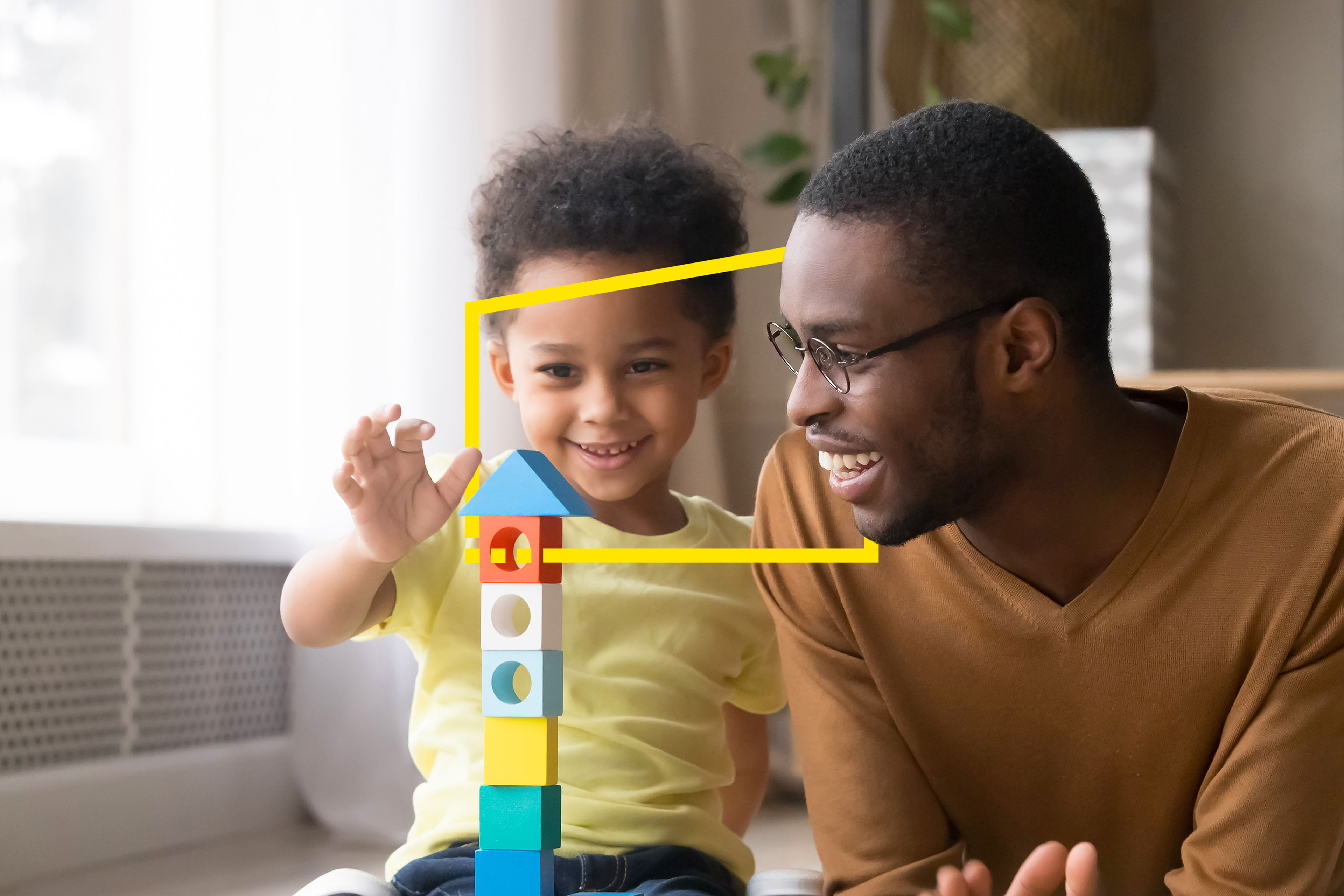EY se refiere a la organización global, y puede referirse a una o más, de las firmas miembro de Ernst & Young Global Limited, cada una de las cuales es una entidad legal independiente. Ernst & Young Global Limited, una compañía británica limitada por garantía, no brinda servicios a los clientes.

Responder a las ideas preconcebidas de COVID-19 de lo que se necesita para crear una experiencia de salud digital.
En resumen
- El auge de la telemedicina aceleró el camino de la atención sanitaria hacia un ecosistema de salud inteligente, pero la "adherencia" futura depende de la comodidad y la velocidad.
- Existe un gran potencial de crecimiento para la adopción por parte de los médicos de tecnologías de atención remota centradas en el paciente, que son clave para un ecosistema de salud inteligente integrado.
COVID-19 expuso la dependencia del sistema de salud de Estados Unidos de la prestación de atención presencial. Las tecnologías de salud digital necesarias para respaldar un ecosistema de salud sin interrupciones, en cualquier momento y en cualquier lugar, han estado disponibles durante al menos una década, pero hasta hace poco, ha habido poca presión para que los consumidores, los médicos y los sistemas de salud adopten estas tecnologías.
Lo que comenzó como un cambio necesario hacia la atención remota habilitada digitalmente ya ha remodelado la prestación de atención a corto plazo. Por ejemplo, casi la mitad de las visitas de atención primaria de Medicare en abril de 2020 se realizaron a través de telemedicina (43,5 %) en comparación con menos del 1 % en febrero (0,1 %).1 Lo que no está claro es si el aumento de la telemedicina ha hecho que los consumidores y los médicos estén más abiertos a la atención virtual en el futuro y si acelerará el viaje de las organizaciones de atención médica hacia un ecosistema de salud inteligente.
Para abordar estas preguntas, EY encuestó a más de 2.000 consumidores de atención médica y 300 médicos de Estados Unidos en julio de 2020 para comprender su utilización y opiniones sobre la tecnología de atención médica (consulte "Acerca del estudio"). Descubrimos que la respuesta del sistema de salud de Estados Unidos a la COVID-19 aceleró la adopción de la tecnología sanitaria y rompió las ideas preconcebidas sobre lo que se necesita para crear una experiencia de salud digital. El resultado es una mayor "adherencia" de la telemedicina a corto plazo y una mayor apertura para adoptar tecnologías inteligentes de atención médica en el futuro. Estos hallazgos son consistentes con la investigación de EY en 2019, que encontró que estos grupos ya esperaban un cambio significativo hacia un sistema de salud digital en la próxima década, antes de COVID-19.2
Estas circunstancias no son exclusivas de los Estados Unidos. A nivel mundial, los países han experimentado el mismo cambio hacia la atención virtual y se encuentran en una posición similar para reimaginar sus sistemas de salud como un ecosistema físico y virtual integrado.
La necesidad impulsa nuevas experiencias
A medida que la pandemia se aceleró, múltiples factores, incluido el deseo de evitar los entornos de oficina u hospital, limitaron el acceso directo de los consumidores a la atención médica. Como resultado, el 42 % de los estadounidenses omitieron o pospusieron el tratamiento médico, según una encuesta de la Kaiser Family Foundation (KFF).3 Si bien algunos de los que buscaron atención médica requirieron o prefirieron tratamiento en persona, muchos otros utilizaron consultas remotas para evaluar los síntomas de COVID-19 o recibir atención mientras permanecían seguros en casa.
El resultado fue un aumento masivo en la adopción de la telemedicina por parte de los consumidores durante la pandemia. (Figura 1) Nuestra investigación muestra que la penetración de las consultas por video casi se cuadruplicó, del 5 % al 19 %, mientras que las consultas telefónicas se duplicaron con creces, del 11 % al 24 %. Y para la mayoría de los pacientes (70 %), una consulta telefónica funcionó tan bien como comunicar sus síntomas al médico en persona.
Para los médicos, la adopción de la telemedicina era un imperativo médico y empresarial, no una opción. El uso del teléfono y el video se disparó del 20 % a más del 80 %, lo que hizo que la atención virtual estuviera disponible en la mayoría de los consultorios casi de la noche a la mañana (Figura 1). Esta tendencia se dio no solo para la atención primaria y los consultorios especializados, sino también para las instalaciones físicas, como hospitales y centros de atención ambulatoria.
Los médicos informan que trasladar la mayor cantidad de atención posible a canales virtuales les permitió atender a más pacientes durante la pandemia de lo que hubiera sido posible de otra manera. La adopción casi universal de la telemedicina puede explicar por qué muy pocos médicos creen que sus consultorios perdieron pacientes a manos de proveedores remotos durante la pandemia. Sin embargo, los consultorios con capacidades digitales más profundas y puertas de entrada digitales atractivas pueden tener una ventaja a largo plazo en el acceso a los pacientes y una experiencia de cliente más satisfactoria. Por lo tanto, no es sorprendente que la gran mayoría de los médicos (81 %) planee acelerar la introducción de nuevas tecnologías digitales. Otro 63 % realizará inversiones moderadas o significativas en estas tecnologías en los próximos tres años.
La "adherencia" del futuro depende de la comodidad y la velocidad
Nuestra investigación sugiere que es probable que una mayor adopción de la telemedicina por parte de los consumidores se mantenga por encima de los niveles anteriores a la pandemia y que la adopción de otras tecnologías sanitarias experimentará un crecimiento significativo en los próximos años.
A corto plazo, la utilización de las tecnologías de salud digital disminuirá a medida que crezca la sensación de seguridad de los consumidores y regresen a las visitas en persona (Figura 2). Esta tendencia ya es evidente en los datos de reclamaciones de Medicare a partir de finales de mayo, especialmente en regiones como Nueva York que ya no experimentaban un pico de casos de COVID-19. Esta tendencia se ve respaldada por los datos del EY Future Consumer Index, que indica que el 94 % de los consumidores estadounidenses se sentirían cómodos reanudando las citas médicas en persona en los próximos meses.
A pesar de este descenso, la penetración de las consultas telefónicas y por vídeo se situará en un nivel superior al de antes de la pandemia. Por ejemplo, la utilización de las videoconsultas será casi el doble de lo que era a principios de año (10 % frente a 5 %). Y aunque el poder curativo del tacto humano es una creencia clave en la medicina, la pandemia ha revelado que las interacciones en persona no siempre son necesarias. Incluso entre los consumidores que han utilizado la telemedicina pero prefieren las visitas en persona, es probable que el 49 % siga utilizando la telemedicina.
A más largo plazo, nuestra investigación sugiere que la penetración de todas las tecnologías digitales se triplicará hasta situarse entre el 30 % y el 45 % de los estadounidenses, dependiendo de la tecnología (Figura 2). Si bien gran parte del cambio inicial a la telemedicina fue impulsado por preocupaciones en torno a la seguridad personal, los consumidores indicaron que continuarán usando estas tecnologías por conveniencia y velocidad. Esto explica en parte por qué vemos que la adopción de tecnologías administrativas que agilizan la experiencia del paciente supera finalmente a la telemedicina en su adopción. Estos incluyen la reserva de citas en línea y el pedido de resurtidos de recetas a través de una aplicación. Será fundamental que los proveedores de atención médica tengan en cuenta estos beneficios a medida que buscan integrar la atención virtual y física en los próximos años.
Impulsando el cambio a largo plazo hacia una salud más inteligente
Los desarrolladores, los médicos y los sistemas de salud tienen un papel clave que desempeñar para impulsar el cambio a largo plazo de los consumidores hacia la tecnología inteligente.
En primer lugar, los proveedores deben seguir ofreciendo soluciones digitales, incluso cuando algunos consumidores vuelvan a las visitas en persona. Hacerlo no solo les dará a los consumidores la opción de cómo recibir su atención, sino que también los expondrá a las nuevas tecnologías. Estos incluyen no solo herramientas de telemedicina, sino también cosas como dispositivos portátiles y dispositivos de monitoreo remoto de grado clínico que capturan y transmiten datos biométricos. En este sentido, nuestra investigación muestra una tendencia alentadora. Como vimos en la Figura 2, más del 60 % de los médicos planean seguir utilizando la tecnología de telemedicina después de la pandemia. Además, el fuerte potencial de crecimiento es evidente en la adopción por parte de los médicos de tecnologías más centradas en el paciente, incluida la monitorización remota, que son clave para establecer un ecosistema de salud inteligente integrado.
A continuación, los médicos y los sistemas de salud necesitan un plan para impulsar la adopción de las soluciones existentes para que las personas puedan sentirse más cómodas y dispuestas a aceptar tecnologías inteligentes en el futuro. Vemos una fuerte correlación entre la adopción actual y futura de la tecnología (Figura 3). En promedio, cada tecnología adicional que utilizan los consumidores aumenta su apetito por la tecnología futura en aproximadamente un 5 %. Esto sugiere que impulsar la adopción hoy allanará el camino para una adopción más generalizada de futuras tecnologías inteligentes. El hecho de que el 69 % de los consumidores utilicen actualmente dos o menos tecnologías sanitarias sugiere que se trata de una gran oportunidad. Para capitalizar esto, los médicos y los sistemas de salud deben centrarse en la construcción de un ecosistema digital de soluciones para ayudar a impulsar la adopción cruzada hoy y crear plataformas para soluciones inteligentes adicionales en el futuro.
Por último, los desarrolladores deben crear sus ofertas para abordar las necesidades clave y los puntos débiles de sus usuarios (Figura 4). Esto significa desarrollar tecnologías que se centren en la usabilidad y se integren a la perfección en los flujos de trabajo de los médicos. No deben comprometer la calidad de la atención ni crear cargas administrativas adicionales para los médicos. Crear para los consumidores significa centrarse en funciones que mejoren la comodidad y la velocidad, como interfaces de usuario optimizadas y un conjunto integrado de herramientas en lugar de muchas aplicaciones dispares.
Aprovechar el impulso de la telemedicina
Un aspecto positivo de la pandemia es que el sistema de salud de Estados Unidos ha dado un paso significativo para ofrecer una experiencia de atención médica más integrada, fluida e inteligente (gráfico 5). Ha desafiado las nociones preconcebidas de cómo se debe prestar la atención sanitaria y ha eliminado las barreras existentes para la adopción de la salud digital. Los sistemas de salud y los médicos no solo han aprendido a brindar atención remota con éxito, sino que tienen la intención de hacerlo en el futuro como una parte integral de su combinación de servicios. Los consumidores han visto de primera mano cómo las tecnologías sanitarias pueden simplificar, mejorar y personalizar sus experiencias de atención, y demandarán cada vez más dicha atención en el futuro.
Se ha aprendido mucho sobre cómo integrar y alinear la atención en entornos físicos, remotos y virtuales. Y quedan más aprendizajes por delante a medida que las organizaciones toman las medidas necesarias para continuar la transición hacia una salud más inteligente. Esto incluye el desarrollo de normas técnicas y de comunicaciones compartidas; permitir el intercambio autorizado y seguro de información de salud; y el desarrollo de las capacidades para extraer información procesable de las grandes cantidades de datos de salud estructurados y no estructurados. Estos elementos técnicos son fundamentales para crear el entorno de datos adecuado para un ecosistema de salud conectado y se tratan en nuestro reciente artículo sobre arquitectura de información sanitaria.
Al adaptar la atención para satisfacer las necesidades de los pacientes durante la pandemia, lo que finalmente ha ocurrido es un cambio en las creencias arraigadas sobre lo que se necesita para brindar una experiencia de atención médica digital. Los ejecutivos y líderes de la atención médica deben hacerse tres preguntas a medida que reimaginan su transformación de salud inteligente:
- ¿Está adoptando un enfoque audaz, holístico y basado en datos para identificar y priorizar qué oportunidades de salud inteligente perseguir?
- ¿Su ecosistema de salud inteligente tiene puntos de entrada claros para los consumidores y los expondrá a nuevas experiencias para impulsar la demanda orgánica de nuevos servicios?
- ¿Está siguiendo un enfoque que prioriza a las personas en lugar de la tecnología para su estrategia de inversión y transformación digital?
Acerca del estudio
En julio de 2020, EY encuestó en línea a 300 médicos y 2.032 consumidores de atención médica en los Estados Unidos. Los médicos incluían médicos de atención primaria y medicina familiar, así como especialistas quirúrgicos y no quirúrgicos. Los encuestados trabajaron en una variedad de entornos de práctica, incluidos solos, grupales y hospitales. Los datos de los consumidores se ponderaron para reflejar la población y las distribuciones geográficas.
El objetivo del estudio fue examinar las actitudes y la propensión de los consumidores y médicos a utilizar las tecnologías de salud digital para la salud y el bienestar, así como explorar la voluntad de participar en futuras tecnologías de atención médica que están acelerando el rostro cambiante de la atención médica.
Definiciones en nuestro estudio
- Salud digital
Tecnologías de salud digital como una amplia gama de tecnologías que sustentan diferentes formas de brindar atención médica, impulsan mejores resultados de salud y optimizan los modelos de negocio.
- Telesalud
Telesalud (de la cual la telemedicina es un aspecto) como una consulta interactiva entre el paciente y el médico o entre médicos a través de una variedad de capacidades (voz, video o ambas) y modalidades (sincrónicas o asincrónicas) a lo largo de la continuidad de la atención.
- Smart Health
Salud inteligente como una red de atención médica interconectada y sin interrupciones, o un ecosistema que utiliza tecnología de vanguardia para descentralizar la prestación de atención, optimizar el uso de recursos y los resultados de la atención.
Michael Wheelock, PhD, EY Global Advanced Insights Lead, y Sheryl Coughlin, PhD, EY Global Health Sciences and Wellness Senior Analyst, contribuyeron a este artículo.
Resumen
La COVID-19 ha impulsado la transformación digital de la industria de la salud hasta un punto de no retorno. El cambio para brindar una experiencia de atención médica digital mediante la creación de capacidades digitales más profundas y puertas de entrada digitales atractivas puede brindar una ventaja a largo plazo en el acceso a los pacientes y una experiencia del cliente más satisfactoria.
Noticias relacionadas
¿Cómo diseñará la arquitectura de la información para desbloquear el poder de los datos?
A medida que las tecnologías emergentes transforman la salud y el cuidado, exploramos cómo crear el entorno de datos adecuado para un ecosistema de salud conectado.



